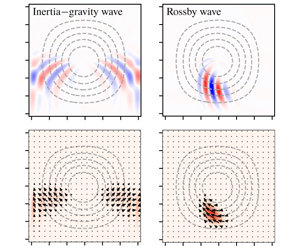Crossref Citations
This article has been cited by the following publications. This list is generated based on data provided by
Crossref.
Venaille, A.
and
Delplace, P.
2021.
Wave topology brought to the coast.
Physical Review Research,
Vol. 3,
Issue. 4,
Perez, N.
Delplace, P.
and
Venaille, A.
2021.
Manifestation of the Berry curvature in geophysical ray tracing.
Proceedings of the Royal Society A: Mathematical, Physical and Engineering Sciences,
Vol. 477,
Issue. 2248,
Savva, M.A.C.
Kafiabad, H.A.
and
Vanneste, J.
2021.
Inertia-gravity-wave scattering by three-dimensional geostrophic turbulence.
Journal of Fluid Mechanics,
Vol. 916,
Issue. ,
Leclerc, Armand
Laibe, Guillaume
Delplace, Pierre
Venaille, Antoine
and
Perez, Nicolas
2022.
Topological Modes in Stellar Oscillations.
The Astrophysical Journal,
Vol. 940,
Issue. 1,
p.
84.
Perez, Nicolas
Delplace, Pierre
and
Venaille, Antoine
2022.
Unidirectional Modes Induced by Nontraditional Coriolis Force in Stratified Fluids.
Physical Review Letters,
Vol. 128,
Issue. 18,
David, Tomos W.
Delplace, Pierre
and
Venaille, Antoine
2022.
How do discrete symmetries shape the stability of geophysical flows?.
Physics of Fluids,
Vol. 34,
Issue. 5,
Venaille, Antoine
Onuki, Yohei
Perez, Nicolas
and
Leclerc, Armand
2023.
From ray tracing to waves of topological origin in continuous media.
SciPost Physics,
Vol. 14,
Issue. 4,
Jones, C. Spencer
Xiao, Qiyu
Abernathey, Ryan P.
and
Smith, K. Shafer
2023.
Using Lagrangian Filtering to Remove Waves From the Ocean Surface Velocity Field.
Journal of Advances in Modeling Earth Systems,
Vol. 15,
Issue. 4,
Leclerc, Armand
Laibe, Guillaume
and
Perez, Nicolas
2024.
𝒫𝒯 and anti-𝒫𝒯 symmetries for astrophysical waves.
Astronomy & Astrophysics,
Vol. 689,
Issue. ,
p.
A237.
Onuki, Yohei
Guioth, Jules
and
Bouchet, Freddy
2024.
Dynamical Large Deviations for an Inhomogeneous Wave Kinetic Theory: Linear Wave Scattering by a Random Medium.
Annales Henri Poincaré,
Vol. 25,
Issue. 1,
p.
1215.
Leclerc, Armand
Jezequel, Lucien
Perez, Nicolas
Bhandare, Asmita
Laibe, Guillaume
and
Delplace, Pierre
2024.
Exceptional ring of the buoyancy instability in stars.
Physical Review Research,
Vol. 6,
Issue. 1,
Onuki, Yohei
2025.
Theoretical and numerical study of internal wave resonance causing vertical mixing in the pelagic ocean.
Oceanography in Japan,
Vol. 34,
Issue. 3,
p.
99.
Leclerc, Armand
and
Laibe, Guillaume
2025.
The Importance of Berry Phase in Solar Acoustic Modes.
The Astrophysical Journal Letters,
Vol. 983,
Issue. 1,
p.
L17.
Braud, Aymeric
and
Gueroult, Renaud
2025.
Spin-orbit interactions induced by light drag in moving media.
Physical Review A,
Vol. 112,
Issue. 4,
Perez, Nicolas
Leclerc, Armand
Laibe, Guillaume
and
Delplace, Pierre
2025.
Topology of shallow-water waves on a rotating sphere.
Journal of Fluid Mechanics,
Vol. 1003,
Issue. ,


